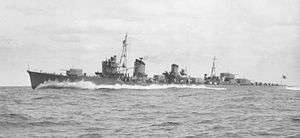Japanese destroyer Amatsukaze (1939)
 Amatsukaze underway on 17 October 1940 | |
| History | |
|---|---|
| Name: | Amatsukaze |
| Ordered: | 1937 |
| Laid down: | 14 February 1939 |
| Launched: | 19 October 1939 |
| Commissioned: | 26 October 1940 |
| Struck: | 10 August 1945 |
| Fate: | Sunk in action, 6 April 1945 |
| General characteristics | |
| Class and type: | Kagerō-class destroyer |
| Displacement: | 2,490 long tons (2,530 t) |
| Length: | 118.5 m (388 ft 9 in) |
| Beam: | 10.8 m (35 ft 5 in) |
| Draft: | 3.8 m (12 ft 6 in) |
| Speed: | 35 knots (40 mph; 65 km/h) |
| Complement: | 240 |
| Armament: |
|
| Service record | |
| Commanders: | Cmdr. Tameichi Hara (April 1940–January 1943) |
| Operations: |
|
| Victories: | USS Barton (DD-599) (1942) |
Amatsukaze (天津風, "Heavenly Wind") was a Kagerō-class destroyer of the Imperial Japanese Navy.
Design and description
The Kagerō class was an enlarged and improved version of the preceding Asashio class. Their crew numbered 240 officers and enlisted men. The ships measured 118.5 meters (388 ft 9 in) overall, with a beam of 10.8 meters (35 ft 5 in) and a draft of 3.76 meters (12 ft 4 in).[1] They displaced 2,065 metric tons (2,032 long tons) at standard load and 2,529 metric tons (2,489 long tons) at deep load.[2] The ships had two Kampon geared steam turbines, each driving one propeller shaft, using steam provided by three Kampon water-tube boilers. The turbines were rated at a total of 52,000 shaft horsepower (39,000 kW) for a designed speed of 35 knots (65 km/h; 40 mph). The ships had a range of 5,000 nautical miles (9,300 km; 5,800 mi) at a speed of 18 knots (33 km/h; 21 mph).[3]
The main armament of the Kagerō class consisted of six Type 3 127-millimeter (5.0 in) guns in three twin-gun turrets, one superfiring pair aft and one turret forward of the superstructure. They were built with four Type 96 25-millimeter (1.0 in) anti-aircraft guns in two twin-gun mounts, but more of these guns were added over the course of the war. The ships were also armed with eight 610-millimeter (24.0 in) torpedo tubes for the oxygen-fueled Type 93 "Long Lance" torpedo in two quadruple traversing mounts; one reload was carried for each tube.[2] Their anti-submarine weapons comprised 16 depth charges.[3]
Service history


During the first year of the Pacific War, the destroyer was under the command of Tameichi Hara and participated in the battles of the Java Sea, Eastern Solomons and the Santa Cruz Islands. During the Naval Battle of Guadalcanal Amatsukaze sank the destroyer USS Barton with two torpedoes and probably damaged USS Juneau with a third, but injudicious use of her searchlights attracted the attention of the light cruiser USS Helena. The ensuing barrage silenced Amatsukaze's guns, knocked out her steering engine and killed 43 of her crew but her turbines were not affected and she was able to withdraw at 20 knots (37 km/h; 23 mph) using emergency manual steering.[4]
On 11 January 1944, while escorting a convoy of four ships in the South China Sea, Amatsukaze was torpedoed by the submarine USS Redfin. The resulting magazine explosion severed the bow of the ship and killed 80 crewman. Miraculously, the ship did not sink. Presumed sunk, the ship was not discovered for six days until she was spotted by a patrol plane. Amatsukaze was eventually towed to Singapore where a temporary bow was rigged.
On 6 April 1945, Amatsukaze was attacked by USAAF B-25s, 6 miles (9.7 km) east of Amoy (24°30′N 118°10′E / 24.500°N 118.167°ECoordinates: 24°30′N 118°10′E / 24.500°N 118.167°E). Her crew managed to beach the ship; salvage attempts were abandoned on 8 April. On 10 April, the ship was scuttled with explosive charges.
In 2012, the wreckage of Amatsukaze was found by a Chinese engineering ship. About 30 tons of the wreckage was salvaged, cut into pieces and sold as scrap metal before the intervention of local relics administration departments. According to Chinese media, a museum will be built to protect the remaining wreckage.[5][6]
References
- ↑ Chesneau, p. 194
- 1 2 Whitley, pp. 200–01
- 1 2 Jentschura, Jung & Mickel, p. 148
- ↑ Hara, pp.134-142
- ↑ http://szb.mnw.cn/html/2012-08/21/content_130105.htm
- ↑ http://bbs.zzfish.cn/read-htm-tid-629854.html
- General
- Chesneau, Roger, ed. (1980). Conway's All the World's Fighting Ships 1922–1946. Greenwich, UK: Conway Maritime Press. ISBN 0-85177-146-7.
- Hara, Capt. Tameichi (1961). Japanese Destroyer Captain. New York: Ballantine Books. SBN 345-02522-9-125.
- Jentschura, Hansgeorg; Jung, Dieter & Mickel, Peter (1977). Warships of the Imperial Japanese Navy, 1869–1945. Annapolis, Maryland: United States Naval Institute. ISBN 0-87021-893-X.
- Whitley, M. J. (1988). Destroyers of World War 2. Annapolis, Maryland: Naval Institute Press. ISBN 0-87021-326-1.